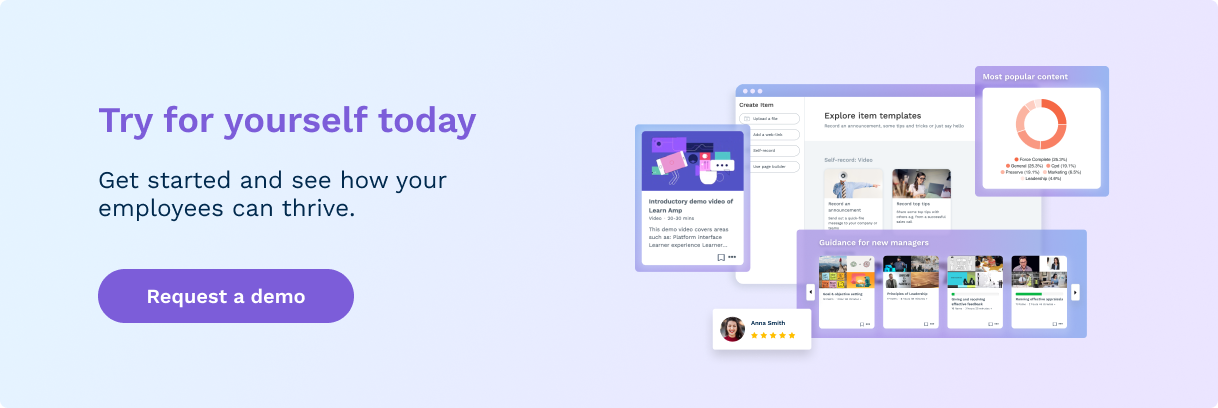Learning and development has changed. Businesses are keen to keep improving how learning content is delivered and received. New ways of doing things are constantly emerging and replacing the old ways. But key to the success of any learning content strategy is how it engages learners, and how well they retain—and use—what they learn.
There has been a shift in thinking about how to deliver learning content which has gone hand-in-hand with a shift in learning systems themselves. Learning Management Systems (LMSs) have become more flexible, and less admin-heavy and top-down to include user-friendly learning design practices.
These shifts bring new opportunities and new challenges. One key issue is how to increase the effectiveness and ‘stickiness’ of content, so that learners not only retain what they have learned but can put it to practical and productive use in their roles.
Here, we look at how the expectations about learning content have changed. We’ll also see how developments in technology can support learners in making the most of their learning—and making it stick.
How the thinking around learning content has shifted
In the old days, learning and development tended to be top-down and admin-driven, with L&D leaders and administrators effectively throwing content at staff and hoping it sticks.
But things have changed. There is a greater recognition of the need for engaging learners if the learning is going to stick. Giving learners more context and understanding of what’s in it for them and what they have to gain, will naturally drive higher motivation and engagement. One-way learning, in which employees are more passive receptors of content, rather than pro-active seekers and self-driven participants in what they learn, is less likely to produce lasting results in terms of productivity.
There has also been a shift in the motivations for L&D. New research from Fosway and Go1 shows that upskilling and reskilling are now the main drivers for learning content[1]. Learners are actively seeking learning and development that lead to career progression opportunities. By factoring skills development into performance and progression conversations, leaders can help align learners’ motivations with company objectives.
This greater demand for upskilling makes sense. Whereas digital skills used to be relevant to some specialised work functions, they are now essential in every area—including learning and development. What’s more, with remote and hybrid work now the norm, employees and teams rely more and more on their tech stack for their training, and to provide them with scalable, one-to-many support.

|
Get actionable insights around Employee Experience and People Development |
Why an LMS or LXP is the best way to make learning stick
Learning content needs to engage employees if it is to stick and make a difference to their performance. So, a platform that is designed to deliver adaptive, blended, collaborative and human-centred learning content in a user-friendly and enjoyable way will go a long way to keeping learners engaged. Incorporating gamification elements into the learning experience gives learners frequent reminders of their achievements. Keeping users focused on how they’re progressing in this way incentivises them to keep progressing.
A learning platform can also facilitate asynchronous e-learning, so that learners can fit their learning to their schedules and learn when and how it suits them. When learners can learn at their own pace, and can review content, they can consolidate their learning and make it stick[2].
What’s more, learning via an LMS/LXP system levels the playing field. Remote and hybrid teams can access the same content, whether they are working from home, travelling or in the office. This creates a more consistent learning experience for everyone.
The type of content your learning system offers is crucial too. Fosway’s research found that 70% of companies are blending off-the-shelf learning content with e-learning integrations and even user-generated content. This variety of resources is more engaging, “accelerates the delivery of learning and enriches the learning process”.
This is why Learn Amp integrates with content providers like Go1, allowing learners to access a huge pool of content, while also enabling them to add, create and share their own learning content with their peers.
Make learning content and learning systems work together
The combination of great content with a great learner experience is key to how engaging your L&D offering is. The content and the process must be enjoyable and easy to use.
First impressions last, so the interface a learning platform uses to deliver content can make all the difference. For example, Learn Amp uses a Spotify-style consumer-grade approach so that browsing and searching for content is easy and intuitive. Adopting the sort of user experience that learners are familiar and comfortable with instantly makes content engaging and accessible[3].
With an LMS or LXP, learners can also learn in the flow of work. By using microlearning modules instead of time-consuming long-form courses, learners can digest learning materials in bite-sized chunks, putting learning content to practical use at the point of need. Employees at Metro Bank, for instance, have used Learn Amp to create TikTok-style videos and share learning with colleagues.
Also, a learning platform offers options to use a whole spectrum of digital content—video presentations, games, quizzes and other interactive activities—that can engage users of all learning styles.
Features like learning playlists capitalise on this by encouraging users to continue their learning journey. Learn Amp uses Learnlists to deliver learning modules. Learnlists are designed to facilitate learning in five stages:
- identifying the learning need
- inspiring interest
- informing and delivering engaging insights
- improving new skills through practical use, and
- assessing the impact of learning on performance.
Social learning is a key component of keeping learners engaged. People learn better when they learn together. With Learn Amp, users can recommend and share learning content peer-to-peer, rather than having it imposed from above. Learners can also optimise each other’s learning with content ratings, Q&A tools, and discussion panels.
Underpinning everything, a good LMS or LXP will enable both learners and employers to track and monitor learning outcomes, so that they can see the impact of learning on productivity in real-time.
Learning into the future
As we’ve seen, learning and development has changed. And it will continue to change. As it does, there are trends to watch and follow, to make sure you can keep your L&D offering aligned with your learners’ needs.
Going mobile: Fosway and Go1 found that more and more learners are accessing learning via mobile devices. This further shows the importance of designing learning systems that tap into the sort of modalities and interfaces that people engage with in their everyday lives.
New types of content: Relevant content is key for engaging learners. When learners can generate their own learning content, based on what is relevant to what they and their colleagues need, it gives them a sense of ownership that drives engagement. Learn Amp enables learners and subject matter experts (SMEs) to create content in formats they are used to, such as TikTok or Instagram-style short-form videos. Not only does this make content relevant and engaging, but it also cultivates a more decentralised and social learning culture across the company.
Content management: Enabling users to create and share learning content can be an amazing generator of interest and engagement. It can come with challenges, though. It makes it all the more important to have effective content management and maintenance, to ensure that user-generated content remains relevant and contributes constructively to the organisation’s knowledge base.
Human-centred learning: Fosway and Go1 stress that learning should be a human-centred, collaborative process. Listening to feedback and involving users in decision-making and design are at the heart of an engaging learning experience and when learners are engaged, the learning sticks.
Ultimately, to make learning really stick, what matters most is that the content is relevant, engaging, easy to digest and valuable. With content from the very best providers like Go1, and intuitive content creation and sharing, Learn Amp’s all-round learning ecosystem gives employees the tools to shape their own learning and delivers real impact.
Resources
- [1] https://insights.go1.com/fosway-report-lp/?utm_medium=email&utm_source=pardot&utm_campaign=lpi_webinar_nov
- [2] https://elearningindustry.com/top-benefits-of-elearning-for-learners#:~:text=1.%20Lectures%20Can%20Be%20Taken%20Any%20Number%20Of%20Times
- [3] https://www.learninglight.com/learn-amp-review/




